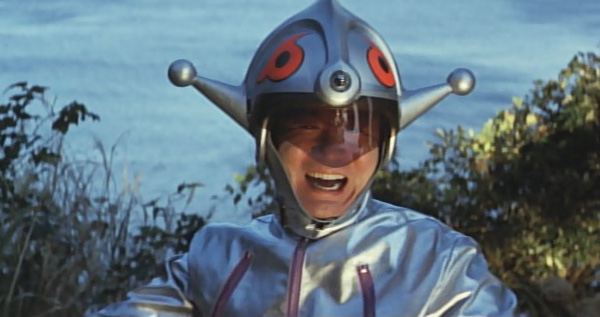Original title: Mekagojira no Gyakushū
The Showa series of Godzilla films limped to a close with the return of the robot Godzilla in a film that promised much – it marked the return of director Ishiro Honda, absent since the awful Gojira-Minira-Gabara: Oru Kaiju Daishingeki/All Monsters Attack/Godzilla’s Revenge (1969) – and to a degree it delivered, though only perhaps because by this time expectations of what the Godzilla films would deliver were so low.
After a lengthy prologue that maps out the entirety of Godzilla’s back story, it takes off as a direct sequel to Gojira tai Mekagojira (1974) with Interpol agents searching for the remains of Mechagodzilla on the floor of the Okinawan Sea, searching for clues about its alien creators, now dubbed the Simeons. Their submarine is attacked by a giant dinosaur called Titanosaurus which was discovered by scientist Shinzô Mafune (Akihiko Hirata). But the scientist’s daughter, Katsura (Tomoko Ai) insists that her father is dead and that at his request she burned all his research into the dinosaur. In fact he’s gone insane and sided with the Simeons, looking to bring about the complete destruction of the human race using Titanosaurus and a newly built Mechagodzilla 2. Godzilla stands against them as Interpol try to perfect a “supersonic wave oscillator” weapon but they are unable to prevent the monsters from attacking Tokyo.

There’s a lot more going on in Terror of Mechagodzilla than that brief synopsis acknowledges, perhaps too much at times as it can be hard to keep up with who’s working for who, who’s double-crossing who and what each of the many parties involved is actually trying to achieve. But overall this is a much better Godzilla film than we’d been used to for some time. Honda gives up on the machinations of the plot for a rousing final reel that rates as among the most impressive of any of the Showa films. It contains traces of the silliness that had overwhelmed the series in the 1970s (at one point Titanosaurus lifts Godzilla up by his nose and waves him about) but for the most part Honda plays it perfectly straight.
No-one knew how to present Godzilla better on screen than Honda and after the loving recap of his adventures so far, his first proper appearance in the film is magnificent, appearing in a blaze of lightning strikes as he advances on Titanosaurus. The new monster is a bit disappointing (it is, after all, just a dinosaur) but the inevitable final fight is well staged wit plenty of memorable moments, particularly a shot of a decapitated Mechagodzilla continuing to fight on despite its seemingly debilitating “injury”.

Terror of Mechagodzilla is notable in one regard – it’s the only Godzilla film to feature mild nudity. It comes in a scene where it is revealed that Katsura is actually a cyborg and undergoes surgery to repair some of her damaged systems. It’s only a brief topless shot (in fact it’s Ai’s head attached to a prosthetic body) but you won’t find it in the American or British versions of the film titled The Terror of Godzilla and Monsters from an Unknown Planet respectively as by this time the series was being firmly aimed at a younger audience in the West.
You do have to wonder what Interpol are doing involving themselves in a case that surely needed military intervention – it’s almost as if writer Yukiko Takayama didn’t actually know what Interpol was… – and not for the first time the invading aliens need the help of human beings to maintain and develop their own technology. These are less intrusive distractions than the silliness of previous films as the rest of Terror of Mechagodzilla is engaging enough to overlook them, boasting excellent special effects, cracking direction, another great Akira Ifukube score and, thankfully, no more bloody annoying kids.

Sadly, none of this was enough to save the Godzilla films. In Japan it was the least-attended of all Godzilla films and in box office terms it remains even now the worst performing. Toho never actually announced that the Godzilla films were ending, they simply put the series on hold for a while. A few years later Star Wars (1977) came along and the vogue for big screen science fiction was now for noisy space operas and giant monster films fell even more out of favour. Almost a decade later, to mark the thirtieth anniversary of the first film, Toho revived Godzilla for a brand new series.